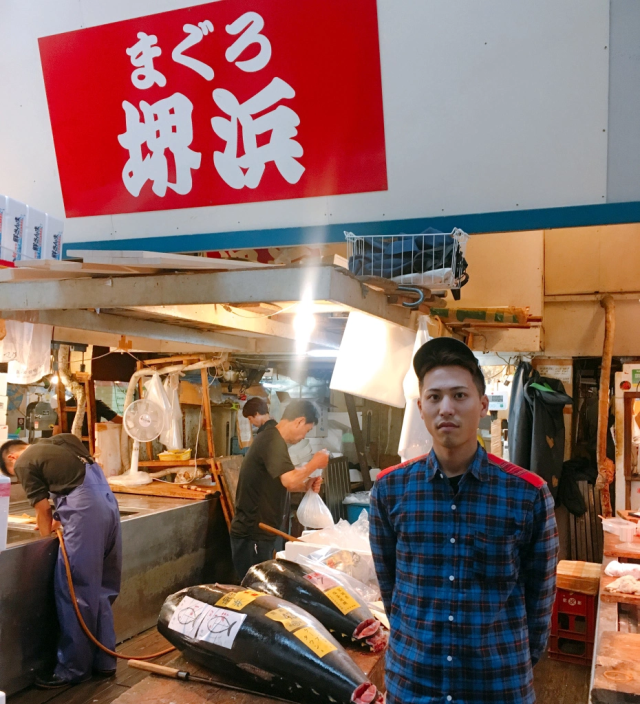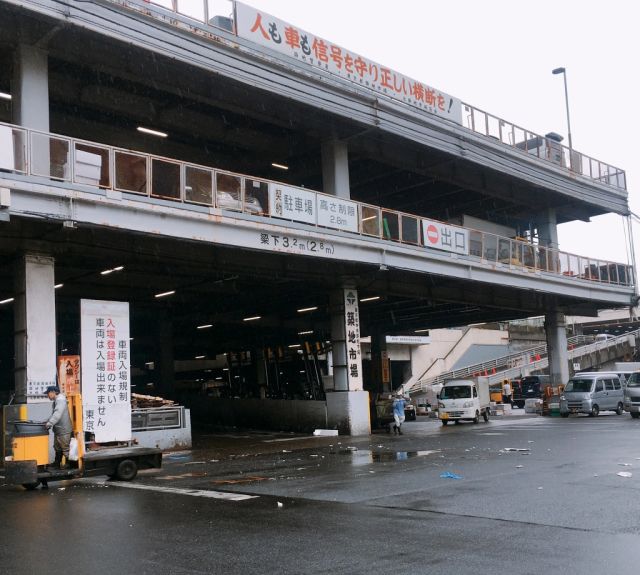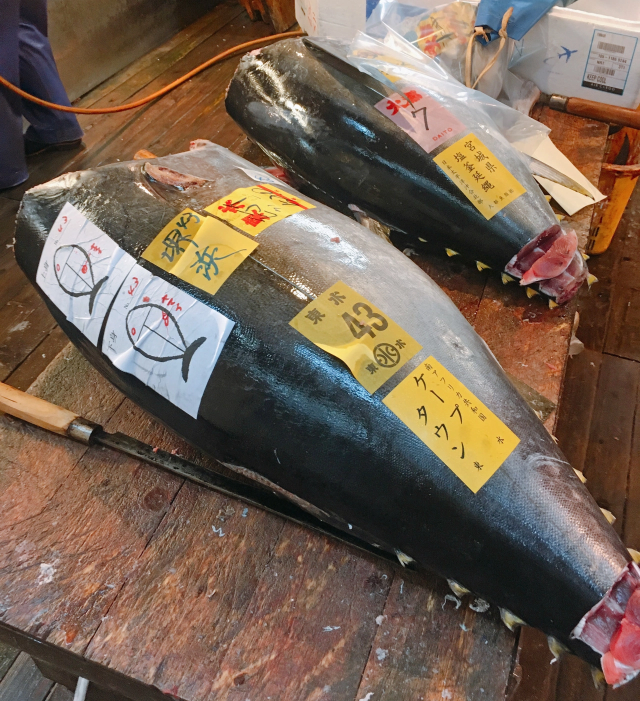
After more than 80 years, Tokyo’s world-famous fish market is relocating, but the head of this 104-year-old wholesaler has one concern.
October 6 marked the end of an era. Since 1935, Tokyo’s Tsukiji fish market had been Japan’s premiere site for seafood sales, but after more than 80 years in business, the facility’s wholesale operations have closed down.
While Tsukiji’s outer market and restaurants remain open, the wholesalers are in the midst of moving farther east to the Toyosu neighborhood, echoing the relocation of Tokyo’s largest fish market from the Nihonbashi district to Tsukiji which took place in the 1930s. Before the big move, we stopped by Tsukiji for one last visit, and to talk with the head of a seafood supplier that’s been in business for over 100 years.
▼ The entrance to Tsukiji’s inner market on October 5
Katsuyuki Hosokawa is the managing director of Nariichi Sakahama. Founded in 1914, his company specializes in tuna (or maguro, as it’s called in Japanese), and the opening of the new market in Toyosu means the company is pulling up its roots following decades in Tsukiji. It was still before noon when we arrived at Nariichi Sakahama’s stall, but the company had already concluded its sales for the day.
▼ Tuna from Miyagi Prefecture (top) and South Africa (bottom)
But the early closing time didn’t mean the company was taking it easy. “I think every wholesaler is in the same position, but we’re swamped with orders right now,” said Hosokawa. Though the Tsukiji market shut down on October 6, the Toyosu replacement won’t open until the 11th, since many of the merchants are small businesses that can’t make the move in a single night. “The market has never been shut down for four days in a row before,” Hosokawa explained, “so we’re flooded with orders from restaurants that need enough fish to tide them over during the transition.”
But at least once everyone is settled in at Toyosu, it’ll be back to business as usual, right? If anything, having a brand-new facility should make work flow even smoother than it did before, shouldn’t it?
Maybe. While more modern buildings and a location that’s less convenient for distracting tourists should contribute to smoother business-to-business sales, Hosokawa has already spotted one potential problem with the not-even-opened-yet Toyosu market.
“There aren’t enough parking spaces,” he said. “Just for the people who will be working at the market, it probably needs about 200 more parking spaces than are planned. For our line of work, people have to show during the middle of the night, and at least before dawn. We sometimes have people coming to our shop at between midnight and one in the morning, and it’s not like they can use public transportation, because the train stop running before that.”
It’s not just workers Hosokawa is concerned about either. Tsukiji is just a short drive from Tokyo’s swanky Ginza neighborhood, and Hosokawa says many buyers from Ginza’s upscale restaurants would come by car to the Tsukiji market to acquire choice cuts of fish to serve to their discerning customers as sushi or sashimi. “If there aren’t enough parking spaces even for workers at the Toyosu market, customers who come by car are going to have to pay to park in a lot,” he said, and he’s worried that this may dissuade some regular customers from continuing with their regular buying habits. “I’m really not sure how it’s going to be once the new market opens.”
▼ Nariichi Sakahama’s Tsukiji stall
Ready or not, though, the Toyosu market opens on October 11.
Photos ©SoraNews24
[ Read in Japanese ]





 Tokyo Tsukiji inner fish market illegally reopens as protesting merchants sneak in, sell sashimi
Tokyo Tsukiji inner fish market illegally reopens as protesting merchants sneak in, sell sashimi With its Inner Market closed down, we stop by Tsukiji to see how Tokyo’s sushi mecca is coping
With its Inner Market closed down, we stop by Tsukiji to see how Tokyo’s sushi mecca is coping Japan’s oldest Yoshinoya branch reopens in a new location: Tokyo’s brand-new Toyosu fish market
Japan’s oldest Yoshinoya branch reopens in a new location: Tokyo’s brand-new Toyosu fish market Tokyo braces for potential rat infestation as Tsukiji fish market closes
Tokyo braces for potential rat infestation as Tsukiji fish market closes Restaurants, Roads, Rats: How has Tsukiji changed after the fish market move?
Restaurants, Roads, Rats: How has Tsukiji changed after the fish market move? What did Shibuya really look like after the crowds on New Year’s Day?
What did Shibuya really look like after the crowds on New Year’s Day? Japanese beef bowl chain Sukiya’s 2026 Smile Box lucky bag basically pays for itself
Japanese beef bowl chain Sukiya’s 2026 Smile Box lucky bag basically pays for itself Starbucks Japan ready to get Year of the Horse started with adorable drinkware and plushies【Pics】
Starbucks Japan ready to get Year of the Horse started with adorable drinkware and plushies【Pics】 7 great places to see Mt. Fuji from without having to climb it
7 great places to see Mt. Fuji from without having to climb it Survey finds more than 70 percent of Japanese children have an online friend
Survey finds more than 70 percent of Japanese children have an online friend Japan’s otoshidama tradition of giving kids money at New Year’s gets a social welfare upgrade
Japan’s otoshidama tradition of giving kids money at New Year’s gets a social welfare upgrade We mixed all 31 flavors of Baskin Robbins ice cream and created a Frankenstein dessert【Video】
We mixed all 31 flavors of Baskin Robbins ice cream and created a Frankenstein dessert【Video】 That time Seiji called JASRAC to ask why he didn’t get paid royalties for his song being on TV
That time Seiji called JASRAC to ask why he didn’t get paid royalties for his song being on TV Godzilla-shaped ice cream on sale in Tokyo near the sight his most adorable rampage
Godzilla-shaped ice cream on sale in Tokyo near the sight his most adorable rampage 7-Eleven Japan’s ramen-cooking robot whipped us up a bowl of noodles【Taste test】
7-Eleven Japan’s ramen-cooking robot whipped us up a bowl of noodles【Taste test】 Hayao Miyazaki says Happy New Year to Studio Ghibli fans with new art for Year of the Horse
Hayao Miyazaki says Happy New Year to Studio Ghibli fans with new art for Year of the Horse We found possibly the quietest Japanese-style hotel in Tokyo’s bustling Shinjuku district
We found possibly the quietest Japanese-style hotel in Tokyo’s bustling Shinjuku district Cup Noodle tries an authentic Jiro-style ramen, but something’s not quite right
Cup Noodle tries an authentic Jiro-style ramen, but something’s not quite right Hello Kitty Choco Egg figures are an adorable trip through three periods of Japanese pop culture【Pics】
Hello Kitty Choco Egg figures are an adorable trip through three periods of Japanese pop culture【Pics】 Japan’s oldest largetooth sawfish in captivity back on display in Mie Prefecture
Japan’s oldest largetooth sawfish in captivity back on display in Mie Prefecture Cyberpunk anime meets traditional culture in Ghost in the Shell gold leaf Japanese changing screens
Cyberpunk anime meets traditional culture in Ghost in the Shell gold leaf Japanese changing screens The best Starbucks Japan Frappuccinos we want to drink again in 2026
The best Starbucks Japan Frappuccinos we want to drink again in 2026 We revisited Sweets Paradise after a decade to see if Japan’s dessert buffet still delivers
We revisited Sweets Paradise after a decade to see if Japan’s dessert buffet still delivers 7-Eleven Japan starts new temporary luggage storage service in over 300 branches
7-Eleven Japan starts new temporary luggage storage service in over 300 branches Disillusionment at Tsukiji’s tourist-target prices led us to a great ramen restaurant in Tokyo
Disillusionment at Tsukiji’s tourist-target prices led us to a great ramen restaurant in Tokyo Starbucks teams up with 166-year-old Kyoto doll maker for Year of the Horse decorations【Photos】
Starbucks teams up with 166-year-old Kyoto doll maker for Year of the Horse decorations【Photos】 Tokyo considering law requiring more trash cans following litter increase in heavily touristed area
Tokyo considering law requiring more trash cans following litter increase in heavily touristed area Tokyo’s Tsukiji sushi neighborhood asks tour groups to stay away for the rest of the month
Tokyo’s Tsukiji sushi neighborhood asks tour groups to stay away for the rest of the month Tokyo event lets you travel back in time, for free, to celebrate 100 years since Showa era start
Tokyo event lets you travel back in time, for free, to celebrate 100 years since Showa era start Sanrio theme park in Japan announces plans to expand into a Sanrio resort
Sanrio theme park in Japan announces plans to expand into a Sanrio resort Japan may add Japanese language proficiency, lifestyle classes to permanent foreign resident requirements
Japan may add Japanese language proficiency, lifestyle classes to permanent foreign resident requirements Stamina-destroying “Paralysis Noodles” are Tokyo’s newest over-the-top ramen innovation
Stamina-destroying “Paralysis Noodles” are Tokyo’s newest over-the-top ramen innovation Survey asks foreign tourists what bothered them in Japan, more than half gave same answer
Survey asks foreign tourists what bothered them in Japan, more than half gave same answer Japan’s human washing machines will go on sale to general public, demos to be held in Tokyo
Japan’s human washing machines will go on sale to general public, demos to be held in Tokyo Japan’s deadliest food claims more victims, but why do people keep eating it for New Year’s?
Japan’s deadliest food claims more victims, but why do people keep eating it for New Year’s? We deeply regret going into this tunnel on our walk in the mountains of Japan
We deeply regret going into this tunnel on our walk in the mountains of Japan Studio Ghibli releases Kodama forest spirits from Princess Mononoke to light up your home
Studio Ghibli releases Kodama forest spirits from Princess Mononoke to light up your home Major Japanese hotel chain says reservations via overseas booking sites may not be valid
Major Japanese hotel chain says reservations via overseas booking sites may not be valid Put sesame oil in your coffee? Japanese maker says it’s the best way to start your day【Taste test】
Put sesame oil in your coffee? Japanese maker says it’s the best way to start your day【Taste test】 No more using real katana for tourism activities, Japan’s National Police Agency says
No more using real katana for tourism activities, Japan’s National Police Agency says Starbucks Japan reveals new sakura drinkware collection, inspired by evening cherry blossoms
Starbucks Japan reveals new sakura drinkware collection, inspired by evening cherry blossoms Updated cherry blossom forecast shows extra-long sakura season for Japan this year
Updated cherry blossom forecast shows extra-long sakura season for Japan this year Tokyo Tsukiji fish market site to be redeveloped with 50,000-seat stadium, hotel, shopping center
Tokyo Tsukiji fish market site to be redeveloped with 50,000-seat stadium, hotel, shopping center Tsukiji Fish Market in Tokyo closes for relocation, marks end of an era in Japan【Pics & Video】
Tsukiji Fish Market in Tokyo closes for relocation, marks end of an era in Japan【Pics & Video】 Tsukiji fish market vendors move to Toyosu in huge fleet of turret trucks【Pics & Video】
Tsukiji fish market vendors move to Toyosu in huge fleet of turret trucks【Pics & Video】 Sushi Dai and other famous restaurants from Tsukiji fish market open at new Toyosu location
Sushi Dai and other famous restaurants from Tsukiji fish market open at new Toyosu location How to choose a great block of sashimi-grade tuna – 66-year maguro master shares his protips
How to choose a great block of sashimi-grade tuna – 66-year maguro master shares his protips Toyosu fish market opens with tuna auction, traffic jams, accidents, and turret truck fire
Toyosu fish market opens with tuna auction, traffic jams, accidents, and turret truck fire Tsukiji Fish Market Vendor Releases Tuna For Home Assembly
Tsukiji Fish Market Vendor Releases Tuna For Home Assembly Tsukiji alternative – Tokyo has a second fish market, and it turns out it’s awesome too
Tsukiji alternative – Tokyo has a second fish market, and it turns out it’s awesome too Tokyo’s Tsukiji sushi neighborhood asks tour groups to stay away for the rest of the month
Tokyo’s Tsukiji sushi neighborhood asks tour groups to stay away for the rest of the month Tuna sells for record 333.6 million yen at Toyosu Fish Market auction in Tokyo
Tuna sells for record 333.6 million yen at Toyosu Fish Market auction in Tokyo Edo-themed onsen and restaurant complex opens in Tokyo, but do overseas tourists know about it?
Edo-themed onsen and restaurant complex opens in Tokyo, but do overseas tourists know about it? Let’s take a tour of the best sushi in Tokyo’s Tsukiji Fish Market with Mr. Sato! (Part 1)
Let’s take a tour of the best sushi in Tokyo’s Tsukiji Fish Market with Mr. Sato! (Part 1) Huge tuna fish sells for a whopping 190 million yen at the first wholesale auction of the year
Huge tuna fish sells for a whopping 190 million yen at the first wholesale auction of the year Bluefin tuna fish sells for bargain low price of roughly US$200,000 in Tokyo auction
Bluefin tuna fish sells for bargain low price of roughly US$200,000 in Tokyo auction Huge fire breaks out at Tokyo’s world-famous Tsukiji Fish Market【Videos, photos】
Huge fire breaks out at Tokyo’s world-famous Tsukiji Fish Market【Videos, photos】 Tokyo’s newest hot spring bathhouse and foodie spot opening next to Japan’s biggest fish market
Tokyo’s newest hot spring bathhouse and foodie spot opening next to Japan’s biggest fish market
Leave a Reply